
If the application uses functions that require advanced capabilities (AllFiles, DRM, TCB, CommDD, DiskAdmin, NetworkControl, MultimediaDD), you must use the standard Symbian Signed process to have the application Symbian Signed. Depending on the capabilities used, you may use either the Express Signed or the Certified Signed path, or the manufacturer-specific channel (for AllFiles, DRM, and TCB).
This section describes how to get your application and the wrapper package Symbian Signed. It is assumed that you are already familiar with Qt build tools and the build process and you have prepared the application, as instructed in Preparing Applications for Nokia Store or Symbian Signed.
In the list below, Application is the target application name defined in the .pro file.
- Open the command prompt from the Qt SDK menu. Pick the compilation target of your choice. For example, if you want to compile your application on top of the Symbian Belle release and Qt 4.7.4, open
Start > Qt SDK > Symbian Belle Qt 4.7.4 > Qt 4.7.4 for Symbian Belle Command Prompt
- Change to the project directory. For example:
cd C:\Sources\Application
- To build the application and sign the .sis file with the Publisher ID certificate obtained from TC TrustCenter, enter the following command:
make sis QT_SIS_CERTIFICATE=publisherid.cer QT_SIS_KEY=publisherid.key
Note: Here, the publisher key and certificate are located in the current folder. If they are located in another folder, specify the path as well as the filename.
- Submit the created .sis file (application.sis) to Symbian Signed for certification.
Note: Ensure that your application complies with the Symbian Signed Test Criteria before submitting the file for certification. Also, if the file is intended for Nokia Publish, verify that the application complies with Nokia Store publishing requirements.
- After receiving the .sis file from Symbian Signed, copy it over the old application.sis.
- To create a Smart Installer wrapper package, enter the following command:
C:\Sources\Application> make ok_installer_sis QT_SIS_CERTIFICATE=publisherid.cer QT_SIS_KEY=publisherid.key
Note: The ok_installer_sis make target is used here instead of installer_sis target to avoid overwriting the already signed application.sis.
- Submit the created wrapped .sis file, application_installer.sis, to Symbian Signed. Express Signed is a suitable signing option for the wrapper package. The capabilities used in the application do not play a role here, because the wrapper package is already signed.









